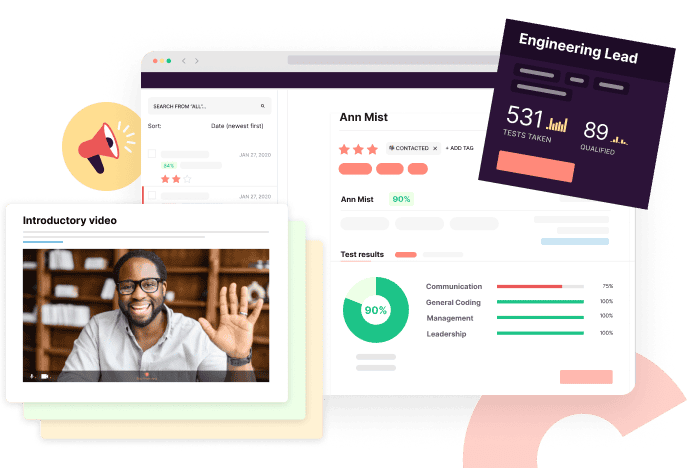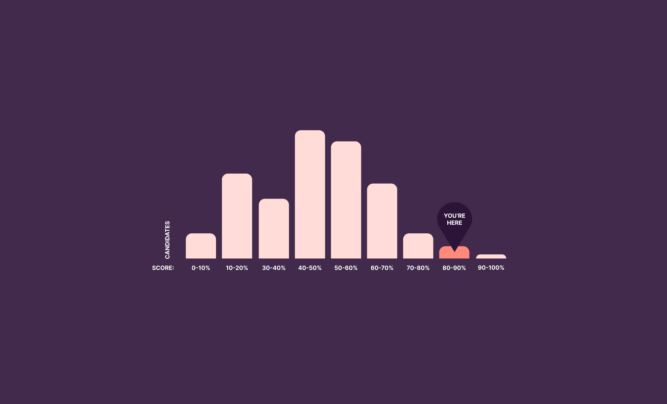Minimizing bias in your hiring process can boost company diversity by 19%, but falling victim to the halo and horn effect can easily lead even the most experienced recruiter to make negative assumptions and collective judgments about otherwise great candidates.
The horn and halo effects are two common types of cognitive bias you need to understand when building a fair hiring process. They’re common culprits for bad hires, reduced diversity, and unfair hiring processes.
To minimize the halo and horn effect, we’ve created this quick guide to help you understand how they manifest in the hiring process, why it’s important to keep an eye on them, and six ways you can mitigate their impact on your candidate selection process.
TL;DR — Key Takeaways
The horn effect is a cognitive bias that makes us treat someone worse if we have a negative first impression of them. The halo effect is the opposite — it makes us treat someone better if they make a good impression on us.
An example of the halo and horn effect in modern hiring might look like a candidate who is good-looking being seen as smarter than not-so-good-looking candidates (halo effect), while a candidate who is late to the interview might wrongly be seen as also being disorganized, lazy, and irresponsible (horn effect).
Both of these negatively impact the fairness of the hiring process and can lead to bad hires and reduced diversity in your company.
You can integrate measures to combat this bias into the structure of your recruiting process. Some great ways to start are by anonymizing applications, having more than one person present at interviews, and using skills tests to help make data-driven decisions and eliminate subjectivity.
What is the horn effect bias?
The horn effect is a cognitive bias that causes us to immediately attribute negative characteristics to a person based on a single negative trait. It’s a snap judgment.
We get an overall negative impression of them while overlooking any other positive traits they may possess. This negative opinion can stem from someone’s physical attributes, mannerisms, or attitude.

What is the halo effect bias?
The halo effect is the opposite of the horn effect. It’s an unconscious bias where just one redeeming aspect of a person makes us see them in a very positive light. With the halo effect, negative traits are overlooked, and positive qualities are ascribed even if there is no evidence to back them up.
For example, a recent study found that across cultures, we’re more likely to say pretty people are also smarter and more trustworthy — an example of attractiveness bias. With the halo effect, perceived negative aspects are given less importance in favor of a strong positive first impression.

Difference between the halo and horn effects
The halo and horn effects are opposing cognitive biases that can flare up in the recruitment process. To recap…
The Halo Effect: A positive impression that makes us treat someone better.
For example, giving preferential treatment to a candidate who uses the same expressions as you might lead you to overlook other more qualified candidates who perhaps express themselves differently.
The Horn Effect: A negative impression that makes us treat someone worse.
On the flip side, hiring managers might assume someone who shows up five minutes late to an interview would also struggle with poor performance in the role, despite their great credentials.
They’re both an unfair assumption that leads to snap judgments about potential candidates. If you’re not careful, this can unknowingly lead you to hire people similar to you. That’s not great for diversity — which we know is a huge driver of success and innovation.
How does the horn effect affect hiring decisions?
It’s tough to change a human’s opinion. Once we make our minds up about someone, we tend to keep looking for and finding information that validates our opinion. This is known as confirmation bias.
In hiring, that means if you start off on the wrong foot, it’s that much harder to level the playing field again. Similarly, once you’re in good with someone, it’s harder to mess up.
On a certain level, this is just human nature. However, that’s what makes understanding how the halo and horn effect show up in the recruitment process all the more important.
Horn effect examples
If a candidate comes to an interview with a perceived “poor” physical appearance, this might lead the hiring managers to think they are also lackluster in other areas. This could be the difference between landing the job or not.
Another example of the horn effect at work is judging candidates from your out-group more harshly for a single trait than members you perceive to be part of your in-group.
Unfortunately, this can often mean people from a minority group can be unfairly treated and have to work harder to get the same recognition or to make a better positive impression.
How does the halo effect affect hiring decisions?
The halo effect overemphasizes a candidate’s perceived good qualities. This means that if you fall victim to the halo effect, you could be giving them more credit than they’re really due.
Unfortunately, this invalidates any objectivity you might have initially brought into the recruitment process in other areas (like using blind hiring tools and skills assessments) and can lead to unfair candidate evaluations.
Halo effect examples
If you’re reviewing candidates and see a name like Google, Harvard, or Ferrari on their resume, that might leave you with a positive impression of the candidate. It might skew your perception of their actual capabilities or lead to you being more forgiving of a very clearly negative trait.
For example, someone who is well-spoken and communicates directly is seen as more knowledgeable than someone more reserved and shy.
Obviously, being timid doesn’t mean you’re ignorant on a topic, but this is how the halo effect works. It assigns those with one positive attribute with more positive attributes, even though they might not be real.
How to avoid the halo and horn effect in hiring
Whether the halo or horn effect, hiring processes littered with unconscious bias can lead to poor hiring decisions. This can result in a lack of diversity, bad hires, potential legal issues, and missing out on great talent.
More diverse companies make more money and have better ideas. Companies with the most gender equality made 15% more, and companies with the highest racial diversity made 35% more than their industry peers.
Basically, it pays to understand how to avoid the halo and horns effect. Here are six things you can do to combat unconscious bias and foster a fairer approach to hiring.

1. Anonymize applications
Anonymizing applications during the resume screening process is one of the easiest things you can do to limit unconscious bias. Removing names, photos, race, age, or other biasing information can massively boost fairness.
A 2017 study found that candidates with “foreign-sounding” names were 28% less likely to be invited to interview than candidates with “Anglo-sounding” names. Anonymizing applications can help you make more objective decisions and promote diversity, and there are plenty of tools to help you do so.
2. Prepare for interviews
The information anonymized at the application stage won’t remain a secret forever. So, you must ensure that when you see your candidates at an interview, you have measures in place to reduce bias, whether that’s trying to avoid the halo effect or horns effect (or any other bias, for that matter!).
Interview training can help with this, as it’s designed to help hiring managers recognize and mitigate unconscious bias by understanding its different forms, like affinity bias, status quo bias, and the pitchfork effect.
A great place to start is with a standardized list of questions or using structured interviews. These can help you focus on standardized scoring techniques instead of first impressions.
3. Provide cognitive bias training
Cognitive bias is when your reasoning is based more on personal experience and perception than logic or probability — for example, being skeptical of a brand’s intentions as a whole because you had one bad experience with them.
Providing cognitive bias training to hiring managers can make them more aware of snap judgments they might make and the impact these judgments have on the hiring process. Running this training regularly with your hiring team can ensure you’re constantly improving, being fairer, and making better hiring decisions.
4. Get multiple hiring opinions
Having two or three people on an interview panel is a great way to mitigate the halo or horn effect. Everyone will have slightly different initial impressions of the candidate, counteracting individual biases.
This leads to more balanced evaluations and increases fairness. If panel interviews aren’t your thing, you can also implement this by introducing group decision-making processes into your recruitment flow.
5. Stay consistent with a candidate scorecard
Designing and using a candidate scorecard is a great way to make more data-driven hiring decisions by standardizing evaluations.
A candidate scorecard is a rating system interviewers use to score a candidate on how well they match a particular set of criteria for a role. Each person conducting the interview completes the same hiring scorecard by rating the candidate’s hard and soft skills listed as categories on the card.
Take a look at our free candidate scorecard template to help you get started! Make it your own based on which biases your team struggles with, such as a reverse halo effect or the tendency to hyperfocus on one negative trait and discard otherwise highly qualified candidates.
6. Rely on data
Objective decision-making in your recruiting process is vital for securing the best talent fairly. Data can help quantify skills and qualifications while reducing subjective judgments.
One easy way to integrate data into the hiring process is with an assessment tool like Toggl Hire, where candidates are evaluated on their specific skills with a 15-minute test.
Skills-based hiring to avoid cognitive biases
It’s tough to eliminate first impressions from any organization’s recruitment process. However, you can work to ensure your first impression of candidates is objective. Using a skills testing tool is a great way to do this. Your first impression of a candidate will be their skill test score — nothing else.

Skills testing and other blind hiring practices help hiring teams avoid cognitive biases and subjective feelings. It also helps teams avoid relying on self-reported information like resumes while ensuring only the best talent makes it to the interview rounds.
While skills-based hiring can reduce bias, it’s important to remember that no method is entirely bias-free. Therefore, this should be combined with other bias-reducing strategies for best results.
Use Toggl Hire to avoid the halo and horn effects
Toggl Hire empowers you to avoid halo and horn effects and make data-driven hiring decisions instead.
Our skills-based assessments provide concrete, quantifiable data about each candidate’s abilities across hundreds of different skill sets. This means you can confidently back your choices with hard data, removing the guesswork from the equation and ensuring every hire is a strategic one.
Get started with a free account to try it out for yourself.

Julia is a freelance writer and fierce remote work advocate. While traveling full-time, she writes about the intersection of technology and productivity, the future of work, and more. Outside work, you can find her hiking, dancing, or reading in a coffee shop.








